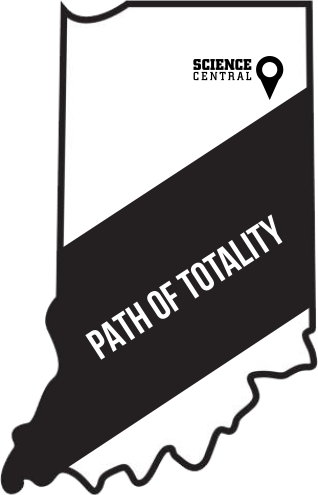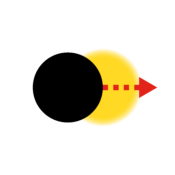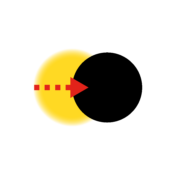Eclipse
- Home
- Eclipse
Eclipse
A solar eclipse will occur on April 8, 2024 – and Science Central will be near the path of totality!
What’s the path of totality? That’s where the moon will totally cover the sun!
Join us for a day celebrating this spectacular astronomical event.

Eclipse Day
Countdown
Eclipse Day
Open from 10 a.m. to 5 p.m., Science Central is offering a variety of programming on Eclipse Day designed to expand the public’s understanding and appreciation of the eclipse. There will be indoor and outdoor programming, the latter of which is weather dependent.
Schedule
10:00 – Science Central opens.
10:30-4:30 – Outdoor activities (weather dependent):
- Activity Tables
- Eclipse chalk art
- Make your own sundial
- Balloon launch @ 2:30
- Cornhole games
- Food trucks: Smoking J’s, Rusty’s Ice Cream
- Safe viewing techniques
- 10+ telescopes & other solar viewers
10:30-2:30 – Indoor activities:
- Cultural storytellers Emily Guerrero & Condra Ridley
- Special eclipse-themed demos
- Tabletop activities
- Learn about scale with our “Small Moon, Big Sun” activity
- Explore sunspots
- Make-it, take-it craft activities
- Pocket Solar System
- Solar Glasses Case
- Aluminum Foil Hats!
- Special eclipse-themed Science On a Sphere (SOS) programming
- Watch the NASA Solar Eclipse 2024 livestream.
11:15-11:45 – “Exploring Eclipses” presentation in the Science On a Sphere theater.
12:00-12:30 – “Modeling Eclipses” presentation in the Demonstration Theater.
1:45-2:15 – “Exploring Eclipses” presentation in the Science On a Sphere theater.
2:30 – High-altitude hydrogen balloon launch on grassy area between Science Central and Lawton Park.
2:45-3:15 – Show time! Step out of Science Central to view the eclipse. Everyone will go outside during this time so that all of us can enjoy the eclipse.
4:30 – Afterparty starts.
5:00 – Science Central closes for visitors not attending the afterparty.
7:00 – Afterparty ends.

Tickets
- General public:
- Children (2 & under): Free
- Children (3+): $12
- Adults: $12
- Seniors (65+): $11
- Science Central members: Free + an extra 5% off in Gift Shop!
Eclipse Day admission does not include access to the Afterparty. Afterparty tickets are purchased separately.
What is and isn't free?
- All outdoor programming at Eclipse Day is free.
- All indoor programming requires Science Central general admission.
- If supplies last, eclipse glasses are available for purchase in the center’s Gift Shop. General admission is not required to enter the shop, but you must depart the building after making your purchase.
- Tickets for Eclipse Day (10-5) and the Afterparty (4:30-7) are purchased separately.



Eclipse Starts: 1:53 p.m.
Maximum Eclipse: 3:10 p.m.
Eclipse Ends: 4:24 p.m.
Eclipse schedule for Fort Wayne, IN
Afterparty
Avoid the traffic jams that occur during eclipses, stay afterwards!
From 4:30 p.m. to 7 p.m., we’ll celebrate the conclusion of the eclipse!
Afterparty attendees can look forward to:
Refreshments
- Pizza
- Liquid-nitrogen ice cream
- Sparkling grape juice
Programming
- Meet-and-greet animals in the center’s Nature Nook and discover how eclipses affect their schedules.
- Learn about ultraviolet light while making bracelets with special beads.
- Get a rare peek at Science Central’s west side, which is typically closed to the public and still resembles a power plant.
Swag Bag ($15 value)
- Commemorative eclipse keychain
- Tektite sample
- Star map
- Moon phase diagram
- General admission ticket to come again
Tickets
- General public: $24
- Day of the event: $29 (sales close at 2 p.m.)
- Science Central member: $22
Eclipse Day admission does not include access to the Afterparty. Afterparty tickets are purchased separately.
Eclipse Day FAQ
The eclipse will occur on Monday, April 8, 2024.
At Science Central, in Fort Wayne, IN, the moon will start to cover the sun at 1:53 p.m.
At Science Central, in Fort Wayne, IN, the moon will be closest to the center of the sun at 3:10 p.m. This stage of the eclipse is known as maximum eclipse.
At Science Central, in Fort Wayne, IN, the moon will be covering 99.8 percent of the sun at maximum eclipse.
At Science Central, in Fort Wayne, IN, the moon will have completely moved off the sun by 4:24 p.m.
Yes, glasses will be available for purchase in Science Central’s gift shop.
Yes, Fort Wayne will see a partial solar eclipse. The path of totality is a thin strip across the Earth where a total solar eclipse will occur.
- Locations inside the path of totality can expect to see the moon totally cover the sun during the course of the eclipse.
- Locations outside the path of totality will view a partial solar eclipse.
The Inside Activities will occur regardless of weather. The Outside Activities will not occur if there is inclement weather. If it rains, you will be able to watch a livestream of the eclipse inside Science Central.
General Eclipse FAQ
A solar eclipse occurs when the moon passes between the Earth and the sun, casting its shadow on the planet. The next total solar eclipse to occur in Fort Wayne will be Aug. 23, 2044!
The path of totality is a thin strip across the Earth where a total solar eclipse will occur.
- Locations inside the path of totality can expect to see the moon totally cover the sun during the course of the eclipse.
- Locations outside the path of totality will view a partial solar eclipse.
No. It is never safe to look at the sun, during an eclipse or otherwise, without eye protection. Looking at the sun without protection can cause permanent eye damage.
No. Only eye protection with solar filters, which are used in eclipse glasses, can sufficiently safeguard your eyes.
